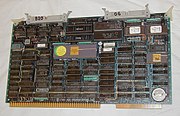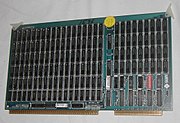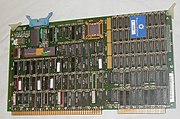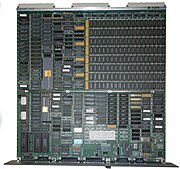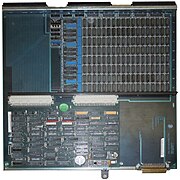Sun-2
This article has multiple issues.Please helpimprove itor discuss these issues on thetalk page.(Learn how and when to remove these template messages)
|
 Sun 2/120 server with SMD disk tower | |
| Developer | Sun Microsystems |
|---|---|
| Type | Workstation |
| Release date | November 1983 |
| Introductory price | 2/120:US$29,300(equivalent to $69,000 in 2023[1]) 2/160:US$48,800(equivalent to $115,000 in 2023[1]) |
| CPU | Motorola 68010 |
| Predecessor | Sun-1 |
| Successor | Sun-3 |
TheSun-2series ofUNIXworkstationsandserverswas launched bySun Microsystemsin November 1983.[2]As the name suggests, the Sun-2 represented the second generation of Sun systems, superseding the originalSun-1series. The Sun-2 series used a 10 MHzMotorola 68010microprocessorwith a proprietary Sun-2Memory Management Unit(MMU), which enabled it to be the first Sun architecture to run a fullvirtual memoryUNIX implementation,SunOS1.0, based on4.1BSD.Early Sun-2 models were based on theIntelMultibusarchitecture, with later models usingVMEbus,which continued to be used in the successorSun-3andSun-4families.
Sun-2 systems were supported in SunOS until version 4.0.3.
A port to support Multibus Sun-2 systems inNetBSDwas begun in January 2001 from the Sun-3 support in the NetBSD 1.5 release. Code supporting the Sun-2 began to be merged into the NetBSD tree in April 2001.[3]sun2 is considered a tier 2 support platform as of NetBSD 7.0.1.[4]
Sun-2 models
[edit]
Models are listed in approximately chronological order.
| Model | CPU board | Display | Max. RAM | Chassis |
|---|---|---|---|---|
| 2/120 | Sun-2 Multibus or Sun-2 Multibus Prime | Monochrome | 8 MB | 9-slot Multibus (deskside) |
| 2/170 | Sun-2 Multibus or Sun-2 Multibus Prime | Optional | 8 MB | 15-slot Multibus (rackmount) |
| 2/50 | Sun 2050 VME | Monochrome | 8 MB | 2-slot VME (desktop) |
| 2/130 | Sun 2050 VME | Monochrome | 8 MB | 12-slot VME (deskside) |
| 2/160 | Sun 2050 VME | Color | 8 MB | 12-slot VME (deskside) |
A desktop disk and tape sub-system was introduced for the Sun-2/50 desktop workstation. It could hold a5 ¼ "disk drive and 5 ¼ "tape drive.It usedDD-50(sometimes erroneously referred to as DB-50) connectors for itsSCSIcables, a Sun specific design. It was often referred to as a "Sun Shoebox".
Sun-1 systems upgraded with Sun-2 Multibus CPU boards were sometimes referred to as the2/100U(upgraded Sun-100) or2/150U(upgraded Sun-150).
A typical configuration of a monochrome 2/120 with 4 MB of memory, 71 MB SCSI disk and 20 MB 1/4 "SCSI tape cost $29,300 (1986 US price list[5]).
A color 2/160 with 8 MB of memory, two 71 MB SCSI disks and 60 MB 1/4 "SCSI tape cost $48,800 (1986 US price list[5]).
A Sun 2/170 server with 4 MB of memory, no display, two Fujitu Eagle 380 MB disk drive, one Xylogics 450 SMD disk controller, a 6250 bpi 1/2 inch tape drive and a 72 "rack cost $79,500 (1986 US price list[5]).
Sun-2 hardware
[edit]
Sun 2 Multibus systems
[edit]Sun 2/120 (9 slot deskside) and 2/170 (15 slot rackmount) systems were based on theMultibusarchitecture. The CPU board was based on a 10 MHz 68010 processor with a proprietary Sun Memory Management Unit (MMU) and could address 8 MB of physical and 16 MB of virtual memory. The top 1 MB of physical memory address space was reserved for the monochrome frame buffer. The Multibus CPU board supported the Sun-1 parallel keyboard and mouse as well as two serial ports.
Sun 2 VMEbus systems
[edit]The Sun 2/50 (2 slot desktop), Sun 2/130 (12 slot monochrome deskside) and Sun 2/160 (12 slot color deskside) used quad-depth, triple height EurocardVMEbusCPU boards. TheVMEbusCPU board was based on the same design as theMultibusCPU but also included 2 MB or 4 MB of memory, the Sun-2 monochrome frame buffer, and 10 Mbit/s Thick Ethernet on board.
Sun provided 1 MB Multibus memory boards and 1 MB and 4 MB VMEbus memory boards but only supported configurations with a maximum of 4 MB RAM. Companies such as Helios Systems also made 4 MB memory boards that would work in Sun systems.
A common frame buffer was the Sun-2 Prime Monochrome Video. This board provided an 1152x900 monochrome display withTTLorECLvideo signals, and keyboard and mouse ports. It normally occupied the top 1 MB of physical memory address space. There was also a Sun-2 Color Video board available that provided an 1152x900 8-bit color display. This board occupied the top 4 MB of address space.
42 MBMFMdisks were commonly used for storage. Two disks could be connected to anAdaptecMFM/SCSIand then to a Sun-2 Multibus Serial/SCSI Host Adapter. The SCSI board provided two additional serial ports. For larger storage requirements, 65, 130, and 380 MBSMDdisks were connected to aXylogics450 SMD Controller. The SMD controller could support four disks even though Sun only supported two. A 20 MBQICtape drive could be connected through anArchiveQIC/SCSI converter. The system also supported 1/2 "tape drives connected to a Computer Products Corporation TAPEMASTER or a Xylogics 472 board.
An Ethernet connection was provided by a Sun board based on the Intel 82586 chip, or a3Com3c400 board. The server could supportdisklessSun-2/50 clients through the Ethernet board.
Other supported Multibus boards included the Sky Computer Floating Point Processor, Sun ALM (Asynchronous Line Multiplexer) with 8 serial ports, and Sun SunLink Communications Processor (SCP) forSNAandX.25connectivity.
Reception
[edit]BYTEin August 1984 described the Sun-2/120 as a "VAX-class machine ", with" superb graphics and excellent response time under loading ".[6]
See also
[edit]Sun timeline
[edit]
References
[edit]- ^abcJohnston, Louis; Williamson, Samuel H. (2023)."What Was the U.S. GDP Then?".MeasuringWorth.RetrievedNovember 30,2023.United StatesGross Domestic Product deflatorfigures follow theMeasuringWorthseries.
- ^"Sun Unveils 32-Bit Workstation".Articles from the Past 25 Years.November 7, 1983. Archived fromthe originalon 2009-08-13.RetrievedMarch 11,2014.
{{cite book}}:|work=ignored (help) - ^"NetBSD/sun2: Frequently Asked Questions".netbsd.org.January 1, 2013.Archivedfrom the original on March 11, 2014.RetrievedMarch 11,2014.
- ^"Platforms Supported by NetBSD".NetBSD.
- ^abcSun U.S. Price List, End User and OEM Version, Effective March 25, 1986, Sun Microsystems
- ^Hinnant, David F. (Aug 1984)."Benchmarking UNIX Systems".Byte.Vol. 9, no. 8. pp. 132–135, 400–409.Retrieved23 February2016.
External links
[edit]- The Sun Hardware Reference, Part 1
- The Sun-2 Hardware Reference:Part 1Archived2007-09-27 at theWayback MachineandPart 2Archived2007-09-27 at theWayback Machine
- soupwizard Sun-2 Archive
- Sun2 Review from UNIX/WORLD October 1984
- Sun 100u with Sun2 boards
- Sun 2 board manuals
- gunkies.org Sun-2 wiki
- The Machine Emulator (Sun-2 Emulator running on NetBSD)



